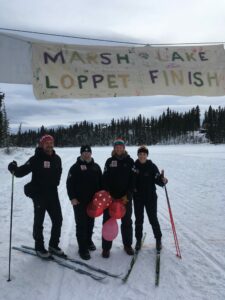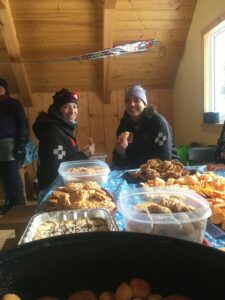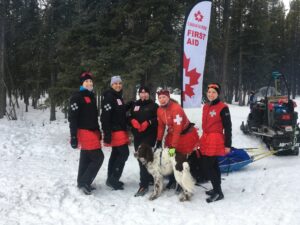By Kirstie Simpson, National Nordic On-snow coordinator (kirstie.simpson@skipatrol.ca)

First, a brief introduction – I’m the newly appointed national Nordic on-snow coordinator and have been a member of the CSP since 1994. I have been active in both the Nordic and alpine sides of patrolling and was awarded CSP No. 813 some years ago.
I have been an alpine skier since I was a child and a Nordic skier since my late teens. I was a cross country ski racer and nationally ranked biathlete in my younger days and joined the patrol as my racing days were coming to an end in order to give back from the “other side” of the ski racing world. At the same time I became an avalanche dog handler in 1990 and was looking for access to a training environment for my dog. As such I joined the CSP as both a Nordic and alpine patroller.
I was a research scientist in the arctic and northern Canada for 35 years as a career and recently retired. I am currently the head of our local hill’s pro patrol.
As an active member, instructor and examiner of both the alpine and Nordic patrol world, I am in the position to compare how we manage the training, operation and standards of the two types of patrol. I see both the parallels and the need to distinguish the differences. One of the parallels is the need to present a credible, professional and well trained patrol to both the public and the racing world.

The Whitehorse Cross Country Ski Club and Nordic Centre is an amazing place with world class trails and facilities. We have decades of Olympic ski racing experience at our club and many nationally and internationally ranked Nordic athletes. Our Nordic centre hosts many sanctioned race events with a very active competitive racing program as well as strong recreational program. Sanctioned races cannot be held without the presence of an accredited first aid provider and the CSP provides that service. As such we need to inspire confidence in our ability to respond as needed.
At the same time, the operationalization of the Nordic patrol is very different from the alpine patrol. Nordic patrollers, when they are not patrolling a race or event, are often on their own or in a team of two persons, patrolling a vast wilderness of ski trails. For example, the Whitehorse Nordic Centre has 85 km of groomed trails for classic and skate skiing and snowshoeing and an additional 20 km of un-groomed single track available for snowshoeing and fat biking. Patrol must be independent and capable of managing incidents that can be many kilometres away from help. Many Nordic patrols also patrol remote events such as loppets where they are even further away from additional help. The ability to hunker down with a patient and provide advanced lifesaving assistance for hours might be a vital skill we have to provide.
One of my key objectives at the Nordic level is to encourage ex- ski racers and medical professionals to join our patrol and to create a strong mentoring program where we can match Nordic patrol with complementary skills together. We have successfully done that in our Nordic patrol.

This post is also available in: Français
